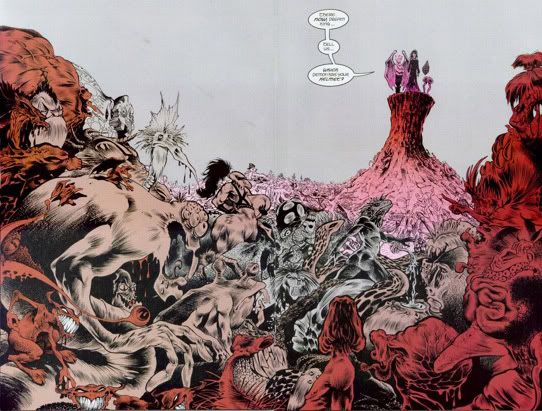
And now we're in Hell! In the course of re-reading, Preludes & Nocturnes has seemed so far to be a 'tour of places that will be important.' Which is why I never ever recommended my friends to start from the beginning. (I usually have them start with the one about the cats, or the one about Midsummer Night's Dream, to get a full flavor of Gaiman's awesomeness before going back to the world-building).
Having read it all before, I am able to recognize the settings and characters who we will meet again, and pay more attention. But if you didn't know that, there shouldn't much incentive to invest in the various storylines and people and places.
But this is the story where that changes. Gaiman creates yet another new setting and a new cast of characters, but manages to somehow convey their importance without the story devolving into a carnival of freaks (the primitive coloring techniques used back then does not help him on this point, as becomes clear in the new Absolute Sandman releases).
I feel that this is the issue where we really start to feel the force of Gaiman's creativity. Everything in this chapter, from the visual design of hell to the game Morpheus must play to win his helmet, comes from a deeply imaginative mind.
Hell is extremely important to the Sandman universe (and the Vertigo universe more generally). Lucifer, like Constantine, has his very own series. But in this issue we only get surface deep; we learn of the triumvirate of lords governing Hell, and we get hints of a very long and deep history between the governors of Hell and Dream himself.
Most importantly, we are reminded, more explicitly than before, that the the world can only define itself, can only find meaning, if Dream exists and is active. For he does not only govern the thoughts that fill our sleep, he governs all subconscious workings of the mind, the imagination, the ability to think beyond oneself, the very ability to believe in something or anything. The ability to hope.
As a side note, we do also get one very important hint to Morpheus' nature: a brief two frame introduction to a woman named Nala. A woman who betrayed him 10000 years ago, that he has yet to forgive. Yet another mystery to be solved in the future (but I do remember how this one ends).
Coming Up: More hijinks with the Justice League, Villains Edition.


Ah, now we’re cooking.
ReplyDeleteThis first page is just wonderful. The self-reflection, the visual backdrop, the tactile sensation of sand between fingers, all combined with some brief and useful incluing about Morpheus and Lucifer. It’s clear from the beginning that Dream isn’t worried about going to Hell – he’s troubled because he knows he has to face down the Devil.
Late on we’ll learn that Dream rather playing the brooding hero to an audience of himself. The internal monologue is useful to us as readers, but it’s also just the sort of thing he does.
The demons, meanwhile, all speak in verse. I think that includes Lucifer, but I’m not sharp enough to track the metre. I recommend reading the dialogue between him and Morpheus aloud.
Again, my limited artistic vocabulary isn’t up to describing the greatness of the work here. It takes a special hand to make a fat dude in red and yellow spandex creepy, but they don’t half pull it off. The big splash page on the ‘vasty’ plains of Hell’ is a real treat. That said, there are several panels where Lucifer looks like a ThunderCat and I don’t believe this is intentional.
What can we say about the duel at the Hellfire Club? Choronzon asserts reality as a battleground, figuring the Dreamlord will be at his weakest there. And he loses, just aAh, now we’re cooking.
This first page is just wonderful. The self-reflection, the visual backdrop, the tactile sensation of sand between fingers, all combined with some brief and useful incluing about Morpheus and Lucifer. It’s clear from the beginning that Dream isn’t worried about going to Hell – he’s troubled because he knows he has to face down the Devil.
Late on we’ll learn that Dream rather playing the brooding hero to an audience of himself. The internal monologue is useful to us as readers, but it’s also just the sort of thing he does.
The demons, meanwhile, all speak in verse. I think that includes Lucifer, but I’m not sharp enough to track the metre. I recommend reading the dialogue between him and Morpheus aloud.
Again, my limited artistic vocabulary isn’t up to describing the greatness of the work here. It takes a special hand to make a fat dude in red and yellow spandex creepy, but they don’t half pull it off. The big splash page on the ‘vasty’ plains of Hell’ is a real treat. That said, there are several panels where Lucifer looks like a ThunderCat and I don’t believe this is intentional.
What can we say about the duel at the Hellfire Club? Choronzon asserts reality as a battleground, figuring the Dreamlord will be at his weakest there. And he loses, just as Lucifer loses, because he doesn’t understand the power that dreams have –in the real world, even in the heart of Hell itself. The stand-off at the end is beautiful, and the first example of one of Sandman’s strongest qualities: conflicts are rarely resolved by a direct physical struggle. The fact that Morpheus is a creature of godlike power in no way makes his life easy or straightforward.
And if you enjoy that kind of approach with a bit of added wickedness, do give Lucifer a try. It's good fun!
I do remember enjoying Lucifer when I read it, though I remember hardly anything about it!
ReplyDeleteThis issue really is wonderful; you can sense that time and effort was put into creating the setting, which is important for any recurring setting.